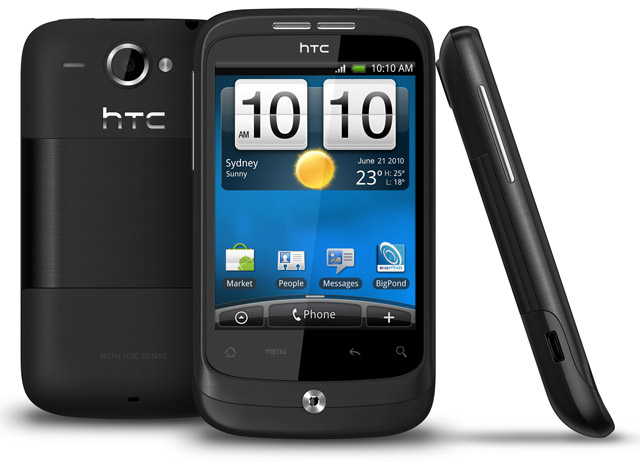
Ten days ago, I reviewed the HTC Wildfire for Android Australia.
I’ve kept the phone for the intervening period to really push some of the features that had bothered me in the initial review to flesh out my opinion on whether the phone was a worthwhile purchase. In particular, these are the issues that had been bothering me:
- Audio quality during calls in different environments
- Onscreen keyboard lag in apps
- Lack of screen real estate affecting usability.
I’ve hammered these three areas and my findings are below.
Call quality
In my initial review, I commented that “the call quality was a little less than expected, especially when making calls in the open with a light breeze – not only could I only hear every second word from the other party, but they also commented that they couldn’t hear me clearly either”.
This puzzled me then, as it did during the time since that I’ve been playing with the Wildfire trying to narrow down the issue. I have used a number of handsets on Telstra’s network and none have exhibited this behaviour so consistently. Whether I was in the office, out and about in Darling Harbour, or walking along city streets, the call audio quality was just abysmal. I could rarely hear much of what the other party said, and frequently had to interrupt with “sorry, I didn’t hear you” in the middle of conversations. They would be doing the same back. Eventually it got to the point where I would hang up and call them on another phone to carry the conversation because the Wildfire became too irritating to use for calls.
However, in other environments, the phone performed quite well. It maintained a loud, clear call for 45 minutes on a Cityrail service between the City and Campbelltown, with minimal audio artifacts and interruption – the call was clear and loud. I expected this was due to minimal background noise – contrasted with being outdoors in a loud city environment – however this is unlikely to be the case, because the train was quite loud – it was during school holidays, after all, and the children were out in force.
The only factor I could consistently identify as a cause of poor call quality was wind – even something as minor as a slight breeze blowing past the phone would disrupt the audio quality and render conversation impossible, whereas in a sheltered environment with still air, this didn’t happen nearly as often.
To me, this is a pretty major issue. I don’t know whether it’s limited to this particular review handset, or whether its endemic to the Wildfire as a design issue, but I certainly did not enjoy using the Wildfire for calls in most environments.
On screen keyboard
HTC’s customised Android keyboard is not optimised for the small screen. It functions quite well on larger framed devices – e.g. the Nexus One, or Desire – but on the smaller screen of the Wildfire, it borders on infuriating.
The lack of CPU power means typing quite often lags behind physical input, and the haptic feedback of the keyboard does nothing to make this process less confusing. It can be turned off, but in my opinion, a phone that requires touchscreen input should really focus on text entry as a priority. On this phone, text entry is annoying at best. Sending SMSs or emails resulted in typographical errors and extraneous periods and punctuation (instead of spaces). This is probably due (in part) to having larger fingers, however a good amount of the population probably doesn’t have fingers dainty enough to accurately operate the keyboard on such a small screen.
Small screen size
If I were to stop at the points above, I’d conclude that the Wildfire is not a particularly useful phone for calls or generating content, but it does well at consuming content.
However, to reach that conclusion would be to ignore a major issue – not just with the Wildfire, but with the Android ecosystem as well. The issue here is that Android apps need to be designed for different screen sizes in order to accomodate the range of devices that run Android. An app designed for a larger screen – such as the Nexus One – will not look pretty on the Wildfire unless the app’s author has accounted for smaller screen devices and created a small screen layout.
Unfortunately, even many popular apps available at the time of testing do not implement a small screen layout, or do so very poorly.
However, as a consumer of content, you don’t need these third party apps – the Wildfire does include a number of ‘built in’ apps which can meet your needs – Twitter, Facebook, web browser etc all come bundled with the phone.
However, HTC Peep (the included twitter client) is not pleasant to use – you can view approximately three tweets at any one time on the screen, because the font size can’t be reduced, and other UI elements take up ridiculous amounts of screen space, making it almost impossible to get a good view of your stream. The same is true of Facebook (albeit, to a lesser extent due to less UI elements getting in the way).
The web browser is also let down by the lack of screen space – the browser performs admirably, however zooming text in to a readable size just reminded me of using Opera Mini on a Nokia 6120c – the ‘view’ is so small, and so restricted, that barely much fits on the screen at all. This leads to a lot of scrolling, a lot of zooming in and out, and browsing becomes.. well.. fairly unpleasant for anything other than mobile-formatted websites.
Postscript
These findings from further examination of these areas confirm, in my mind, that the Wildfire really isn’t the best Android phone on the market, and it (sadly) doesn’t come close. The form factor is great, but the lack of screen real size is a huge letdown. If so much of the front face had not been set aside for capacitive function buttons, the screen size would almost equal that of the Nexus One, and some tweaking of the case design would easily fit that larger display onto the Wildfire without loss of function or design. At the widest point, the capacitive buttons are 15mm tall – on a phone that only stands 105mm, >10% of the front face set aside for these buttons just screams absurdity to me. It’s a poor design choice by HTC.
Putting aside these physical problems, to be, a mobile phone is first and foremost a phone – that is, you can call people on it.
While the Wildfire performs adequately in enclosed environments – offices, trains, cars, etc. – once you get outside, the call quality is just abysmal. It really isn’t useful unless both parties are shouting at each other, and even then, the audio distorts.
If you’re not someone that needs to make a lot of calls outside, then this won’t affect you – as I say – indoors, the Wildfire makes and receives calls just fine, and it has good signal reception (it beats the Nexus One and Desire in some places which is quite a feat). If you’re the type to make calls when walking from A to B, or you like to sit in the sun and give a mate a call, the Wildfire may not be the phone for you.




